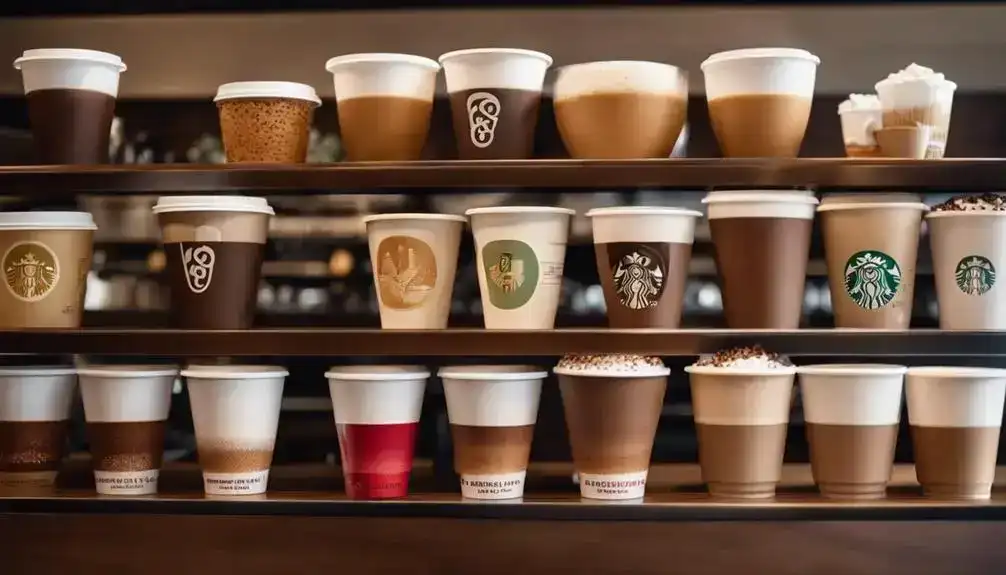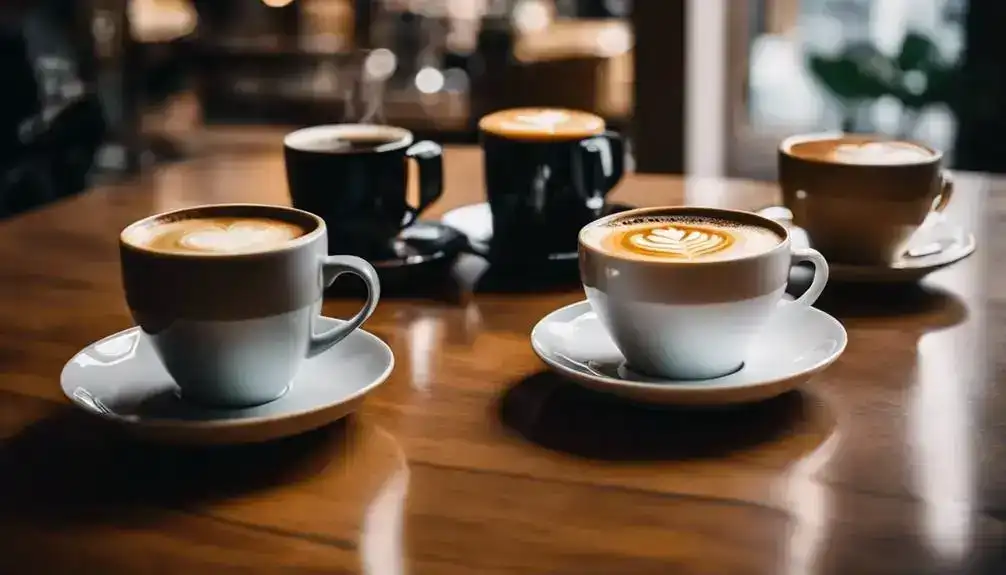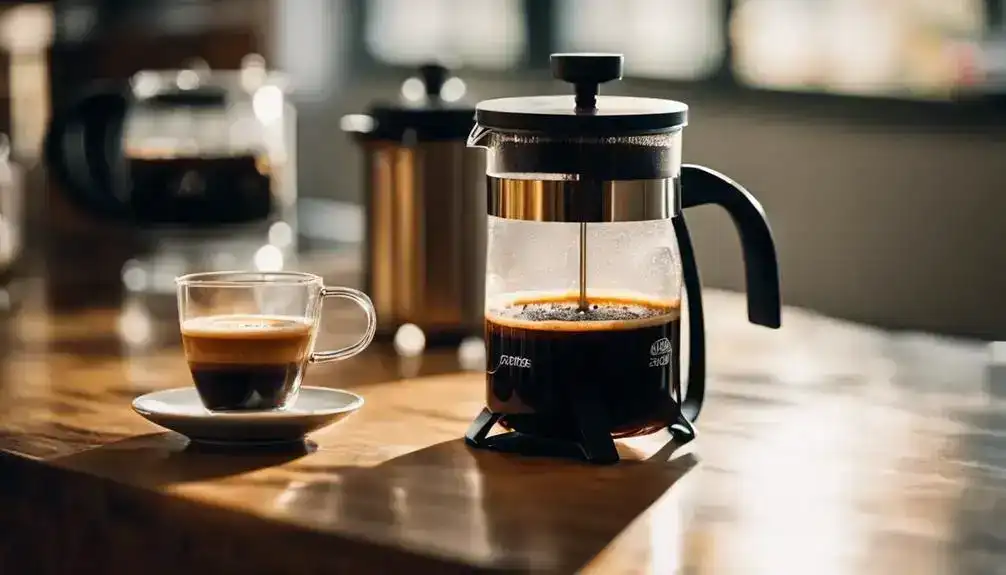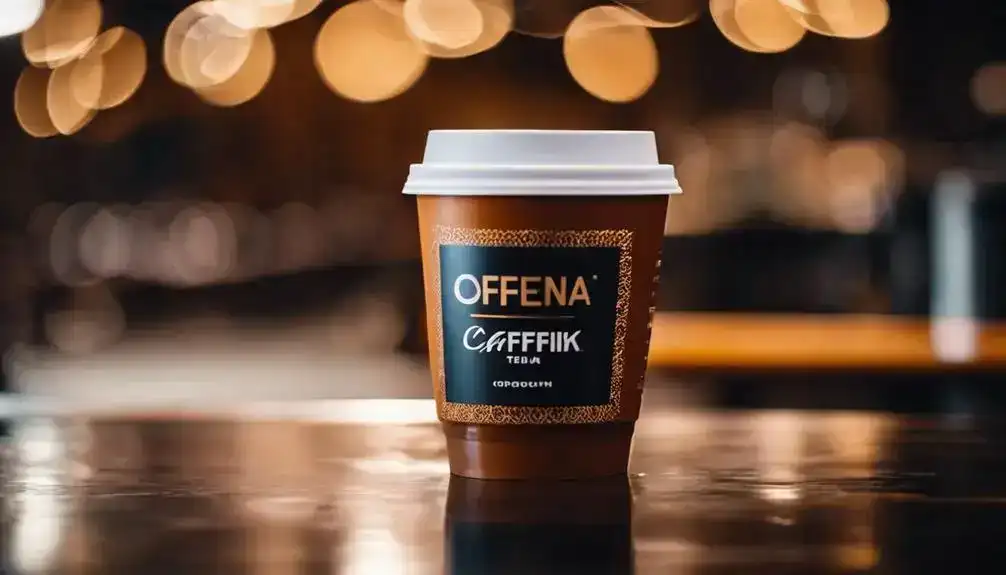In a cup of coffee, the caffeine content varies based on the brew type. Regular brewed coffee typically packs 70-140 mg per 8 oz, while espresso shots contain around 63 mg. Popular brands like Starbucks and Dunkin Donuts offer high-caffeine options, with 180 mg in an 8 oz cup and about 215 mg in a 10 oz serving, respectively.
Factors such as coffee bean types, roasting levels, and serving sizes influence caffeine levels. Bottled coffee and K-Cup options can contain up to 300 mg per serving. Understanding these differences can help you choose the right brew to match your caffeine needs.
Caffeine Content in Different Coffee Types

When it comes to caffeine content in different coffee types, the variability is significant.
Brewed coffee usually contains 70-140 mg of caffeine per 8 oz, while a standard shot of espresso has around 63 mg of caffeine.
Instant coffee falls in the range of 30-90 mg per 8 oz serving.
Caffeine in Brewed Coffee
When it comes to brewed coffee, understanding the caffeine content in different types is key. Here’s what you need to know about regular and decaf brewed coffee:
- Regular Brewed Coffee: Contains about 80-100 mg of caffeine per 8 oz cup.
- Decaf Brewed Coffee: Typically has about 2-15 mg of caffeine per 8 oz cup.
Regular Brewed Coffee
Regular brewed coffee typically contains around 80-100 mg of caffeine per 8 oz cup. When compared to other brewing techniques, this falls within the mid-range for caffeine content. Below is a comparison table showing the caffeine content in different coffee types:
| Coffee Type | Caffeine Content (mg) |
|---|---|
| Regular Brewed Coffee | 80-100 |
| Espresso | 63-75 |
| Instant Coffee | 30-90 |
Decaf Brewed Coffee
Decaf brewed coffee, a popular alternative for those seeking to reduce their caffeine intake, typically contains approximately 2-15 mg of caffeine per 8 oz cup.
| Decaf Brewed Coffee | |
|---|---|
| Starbucks | 2-15 mg |
| Dunkin Donuts | 3-12 mg |
| McDonald’s | 4-10 mg |
| Local Coffee Shop | 5-14 mg |
| Home Brewing | 6-15 mg |
Caffeine in Espresso
When it comes to espresso, understanding the caffeine content is essential for managing your intake. Here are some key points to keep in mind:
- Regular Espresso: An ounce of regular espresso typically contains around 64 mg of caffeine.
- Decaf Espresso: Decaf espresso has no caffeine, offering a suitable option for those looking to avoid stimulants.
Regular Espresso
Typically, a shot of espresso contains around 64 mg of caffeine per 1 oz serving. Regular espresso offers a bold and intense flavor profile, making it a favorite choice for those seeking a quick caffeine boost. In terms of health benefits, espresso is rich in antioxidants, which can aid in reducing inflammation and improving overall well-being.
| Regular Espresso | Caffeine Content (per 1 oz) |
|---|---|
| Regular Espresso | 64 mg |
Decaf Espresso
Moving from regular espresso to decaf espresso, the caffeine content in a 1 oz serving of decaf espresso is negligible. When opting for decaf espresso, consider health benefits and explore decaf espresso alternatives for a flavorful experience without the caffeine kick. Below is a comparison table showcasing the caffeine content in different coffee types:
| Coffee Type | Caffeine Content per 1 oz |
|---|---|
| Regular Espresso | 63 mg |
| Decaf Espresso | 0 mg |
| Instant Coffee | 30-90 mg |
Caffeine in Instant Coffee
When it comes to caffeine content in instant coffee, there are key differences between regular and decaf options. Regular instant coffee typically contains around 62 mg of caffeine per 8 oz serving, while decaf instant coffee has much less, averaging about 2-8 mg per 8 oz.
Understanding these distinctions can help you make informed choices based on your caffeine preferences and intake needs.
Regular Instant Coffee
The caffeine content in regular instant coffee can vary, with an average of around 62 mg per 8 oz serving. Here is a comparison of caffeine levels in different coffee types:
| Coffee Type | Caffeine Content (mg) |
|---|---|
| Brewed Coffee | 95 |
| Espresso | 63 |
| Instant Coffee | 62 |
| Decaf Brewed | 2-15 |
| Decaf Espresso | 0 |
Decaf Instant Coffee
Decaffeinated instant coffee typically contains approximately 2-8 mg of caffeine per 8 oz serving. When opting for decaf alternatives, you notably reduce your caffeine intake. Despite the lower caffeine content, decaf instant coffee still provides a similar taste experience. Health benefits of choosing decaf include reduced risk of insomnia and anxiety. Check the table below for a quick comparison of caffeine content in different coffee types.
| Coffee Type | Caffeine per 8 oz serving (mg) |
|---|---|
| Decaf Instant Coffee | 2-8 |
Caffeine Content in Commercial Coffee Brands

Commercial coffee brands like Starbucks, McDonald’s, and Dunkin Donuts offer a range of caffeine levels in their beverages.
Starbucks brewed coffee packs a punch with about 180 mg of caffeine in an 8 oz cup, while Dunkin Donuts brewed coffee can contain around 215 mg in a 10 oz serving.
McDonald’s coffee falls in the middle with a moderate caffeine content, providing about 109 mg in a 12 oz cup.
Caffeine in Starbucks Coffee
When it comes to Starbucks coffee, you’ll find varying amounts of caffeine in different types of their beverages.
The caffeine content in Starbucks brewed coffee, espresso, and decaf coffee can greatly influence your overall intake.
Understanding the differences in caffeine levels among these popular choices can help you make informed decisions about your coffee consumption.
Brewed Coffee
Starbucks brewed coffee is known for its high caffeine content, with an 8 oz cup containing approximately 180 mg of caffeine on average. When it comes to caffeine extraction methods, Starbucks employs a rigorous brewing process to guarantee a potent brew. Below is a comparison table showcasing the caffeine content in 8 oz servings of brewed coffee from various commercial brands, highlighting Starbucks’ robust caffeine levels.
| Coffee Brand | Caffeine Content (per 8 oz) |
|---|---|
| Starbucks | 180 mg |
| McDonald’s | 109 mg |
| Dunkin Donuts | 215 mg |
| Tim Hortons | 133 mg |
| Peet’s Coffee | 125 mg |
Espresso
Espresso shots from Starbucks typically contain around 75 mg of caffeine per 1 oz serving. When it comes to flavor profiles, Starbucks offers a rich and intense espresso experience. Brewing techniques for espresso involve finely ground coffee beans packed tightly and hot water forced through, resulting in a concentrated shot. Below is a table showing the caffeine content in various Starbucks espresso options:
| Espresso Type | Caffeine Content (per 1 oz) |
|---|---|
| Regular Espresso | 75 mg |
| Decaf Espresso | 0 mg |
Decaf Coffee
Decaf coffee at Starbucks contains approximately 15-30 mg of caffeine per 8 oz cup, offering a lower caffeine alternative for those seeking a milder option. When looking for decaf alternatives, Starbucks provides caffeine-free options that cater to varying preferences.
| Decaf Coffee Brand | Caffeine Content per 8 oz cup |
|---|---|
| Starbucks | 15-30 mg |
Caffeine in McDonald’s Coffee
When considering the caffeine content in McDonald’s coffee, focus on the brewed coffee and espresso options.
- McDonald’s Brewed Coffee: A 12 oz cup of McDonald’s brewed coffee contains about 109 mg of caffeine.
- McDonald’s Espresso: A shot of McDonald’s espresso contains about 71 mg of caffeine.
- These values showcase the moderate caffeine levels in McDonald’s coffee compared to other commercial brands.
Brewed Coffee
In brewed coffee from commercial coffee brands like McDonald’s, the caffeine content can vary, with a 12 oz cup typically containing about 109 mg of caffeine. Caffeine extraction and roast levels impact these levels. See the comparison below:
| Brand | Caffeine Content (mg) |
|---|---|
| McDonald’s | 109 |
Espresso
The caffeine content in McDonald’s espresso, typically found in a single shot, amounts to around 71 mg. Here is a comparison table showcasing caffeine levels in espresso from different commercial coffee brands:
| Coffee Brand | Caffeine Content (per 1 oz shot) |
|---|---|
| McDonald’s | 71 mg |
| Starbucks | 75 mg |
| Dunkin Donuts | 75 mg |
Caffeine in Dunkin Donuts Coffee
When it comes to Dunkin Donuts coffee, you should take into account the caffeine content in their brewed coffee, espresso, and decaf options.
- Brewed Coffee: A 10 oz cup of Dunkin Donuts brewed coffee contains about 215 mg of caffeine.
- Espresso: A shot of Dunkin Donuts espresso contains about 75 mg of caffeine.
- Decaf Coffee: A 10 oz cup of Dunkin Donuts decaf coffee contains about 53 mg of caffeine.
Brewed Coffee
Dunkin Donuts brewed coffee contains approximately 215 mg of caffeine in a 10 oz cup, making it a popular choice for those seeking a strong caffeine kick. The caffeine content in Dunkin Donuts coffee is higher compared to other commercial brands. This bold brew caters to caffeine enthusiasts looking for a robust pick-me-up.
| Coffee Brand | Caffeine Content (per 10 oz) |
|---|---|
| Dunkin Donuts | 215 mg |
| Starbucks | 180 mg |
| McDonald’s | 109 mg |
Espresso
In espresso, the caffeine content at Dunkin Donuts surpasses that of other commercial coffee brands like Starbucks and McDonald’s. Dunkin Donuts’ espresso contains approximately 75 mg of caffeine per 1 oz shot. Here’s a comparison of caffeine concentrations in espresso from different brands:
| Coffee Brand | Caffeine Content (per 1 oz shot) |
|---|---|
| Dunkin Donuts | 75 mg |
| Starbucks | 75 mg |
| McDonald’s | 71 mg |
Decaf Coffee
Decaf coffee at Dunkin Donuts typically contains approximately 53 mg of caffeine per 10 oz serving. For those seeking decaf coffee alternatives, this choice provides a moderate caffeine level compared to regular coffee. While decaf coffee lacks the energy boost, it offers health benefits like reduced anxiety and improved sleep quality. Here is a breakdown of caffeine content in popular Dunkin Donuts coffee options:
| Coffee Type | Caffeine Content (per 10 oz serving) |
|---|---|
| Regular Brewed Coffee | 215 mg |
| Espresso | 75 mg |
| Decaf Coffee | 53 mg |
Caffeine Content in Other Coffee Products

When exploring the caffeine content in other coffee products, you’ll find that bottled coffee can pack a punch with up to 300 mg per serving, while ground coffee and espresso can range from 75-300 mg.
K-Cup coffee, on the other hand, typically contains 75-150 mg of caffeine per 8 oz serving.
These variations in caffeine levels highlight the importance of understanding the potential intake from different coffee products.
Caffeine in Bottled Coffee
bottled coffee products commonly exhibit high caffeine content, with some brands containing up to 300 mg per serving. When you grab a bottled coffee for that quick caffeine fix, it’s essential to be aware of the potency you’re consuming. Below is a comparison table showcasing the caffeine content in popular bottled coffee brands:
| Brand | Caffeine per Serving (mg) |
|---|---|
| Starbucks Doubleshot | 110 |
| Califia Farms Cold Brew | 190 |
| High Brew Cold Brew | 200 |
| Stumptown Cold Brew | 279 |
| Black Medicine Cold Brew | 300 |
Understanding the caffeine levels in these ready-to-drink coffees can help you make informed choices based on your caffeine tolerance and desired energy boost.
Caffeine in Ground Coffee and Espresso
Ground coffee and espresso are notable for their variable caffeine content, which can range from 75 to 300 mg per serving depending on the brand and preparation method. When it comes to caffeine extraction, brewing methods that involve longer water contact and finer grinds tend to extract more caffeine. Different ground coffee varieties can also impact the caffeine levels present in your cup.
Caffeine in K-Cup Coffee
Ground coffee and espresso are renowned for their variable caffeine content, ranging from 75 to 300 mg per serving based on the brand and preparation method, with K-Cup coffee offering a caffeine content of 75-150 mg per 8 oz serving. When it comes to caffeine concentration in different coffee products, brewing techniques play an important role in determining the final caffeine content. Below is a comparison table showcasing caffeine levels in various coffee types:
| Coffee Type | Caffeine Content per 8 oz serving |
|---|---|
| Ground Coffee | 75-300 mg |
| Espresso | 75-300 mg |
| K-Cup Coffee | 75-150 mg |
General Guidelines on Caffeine in Coffee

When considering your caffeine intake from coffee, it’s crucial to adhere to some general guidelines for a safe and enjoyable experience. Here are three key points to keep in mind:
- Safe Daily Intake from Coffee: up to 400 mg per day is considered safe for most healthy adults.
- Sensitivity to Caffeine in Coffee: Individual tolerance levels can vary greatly, impacting how your body responds to caffeine.
- Caffeine Intake for Pregnant and Breastfeeding Women: It’s recommended for pregnant and breastfeeding women to limit their caffeine intake to 200 mg per day.
Safe Daily Intake from Coffee
For most healthy adults, a safe daily intake of caffeine from coffee typically ranges up to 400 mg. Consuming within this limit can help you enjoy the benefits of caffeine without exceeding safe levels. It’s essential to be mindful of your intake to avoid potential side effects associated with excessive caffeine consumption.
| Caffeine Effects | Health Risks | Safe Daily Intake |
|---|---|---|
| Increased Alertness | Insomnia | Up to 400 mg |
| Improved Focus | nervousness | |
| Enhanced Physical Performance | restlessness |
Understanding the effects of caffeine and the risks associated with its overconsumption can guide you in managing your daily coffee intake effectively. Remember, moderation is key to enjoying your coffee without compromising your well-being.
Sensitivity to Caffeine in Coffee
Understanding your sensitivity to caffeine in coffee is essential for managing your daily intake effectively and ensuring you stay within safe limits. caffeine sensitivity varies among individuals, with factors such as age, weight, genetics, and overall health influencing how your body reacts to caffeine.
Being aware of your caffeine tolerance can help prevent adverse health effects like insomnia, nervousness, or an increased heart rate. It’s important to note that abrupt changes in caffeine consumption can lead to withdrawal symptoms such as headaches, fatigue, and irritability.
Caffeine Intake for Pregnant and Breastfeeding Women
Pregnant and breastfeeding women should limit their daily caffeine intake to 200 mg to guarantee the safety of both themselves and their infants.
To safeguard maternal health and well-being, consider the following:
- Caffeine Restrictions: Adhere to the recommended 200 mg limit per day to minimize potential risks.
- Maternal Health: Prioritize the health of both mother and child by monitoring caffeine intake closely.
- Individual Sensitivity: Recognize that individual tolerance levels may vary, necessitating personalized adjustments.
Factors Affecting Caffeine Content in Coffee

Various factors greatly influence the caffeine content in your cup of coffee.
Coffee bean types, roasting levels, brewing methods, and serving sizes all play an important role in determining the amount of caffeine you consume.
Understanding these factors can help you better control your caffeine intake and tailor your coffee choices to your preferences and tolerance levels.
Coffee Bean Types and Caffeine Levels
Different coffee bean types, such as Arabica and Robusta, exhibit varying levels of caffeine content. When considering factors that influence caffeine levels in coffee, the type of bean plays a significant role.
Here are some key points to understand the relationship between coffee bean types and caffeine levels:
- Roast Comparison: The roasting process can impact caffeine content, with lighter roasts generally retaining more caffeine.
- Bean Origins: The geographical origin of the beans can also affect caffeine levels, as different regions produce beans with varying caffeine concentrations.
- Species Varieties: Arabica beans typically contain less caffeine than Robusta beans, making them a preferred choice for those seeking a milder caffeine experience.
Roasting Levels and Caffeine Content
the roasting process greatly influences the caffeine content in coffee, with Lighter roasts generally containing higher levels of caffeine. When considering caffeine extraction and roast levels, here are some key points to keep in mind:
- Caffeine Extraction: Lighter roasts have a higher caffeine content due to the shorter roasting time, allowing for more caffeine preservation.
- Roast Levels: Darker roasts, despite their bolder flavor profiles, tend to have lower caffeine levels as the longer roasting time leads to some caffeine being burned off.
- Impact on Flavor: Lighter roasts may offer a more pronounced caffeine kick, while darker roasts focus more on the roasted flavors, with a slightly reduced caffeine content.
Brewing Methods and Caffeine Extraction
Lighter roasts in coffee brewing methods tend to extract more caffeine due to their shorter brewing times and finer grinds, maximizing caffeine preservation in the final beverage.
When considering caffeine extraction techniques and brewing methods, it’s essential to understand the factors influencing optimal caffeine extraction and brewing times:
- Water Temperature: Higher water temperatures can lead to more efficient caffeine extraction during brewing.
- Grind Size: Finer coffee grounds result in increased surface area for extraction, enhancing caffeine content.
- Brewing Time: Longer brewing times allow for more thorough extraction of caffeine from the coffee grounds.
Serving Sizes and Caffeine Content
Maximizing caffeine content in your coffee is greatly influenced by the size of your serving. When it comes to caffeine intake, the portion control of your coffee plays an important role.
Here are some key factors to take into account for optimizing caffeine content:
- Bigger Cups, More Caffeine: Larger serving sizes naturally contain more caffeine, so choosing a bigger cup can enhance your caffeine intake significantly.
- Effects of Caffeine: Higher caffeine content in larger servings can lead to increased alertness and improved cognitive function, but be cautious with excessive consumption.
- Portion Control: Monitoring the size of your coffee servings is crucial to manage your caffeine intake effectively, ensuring you stay within recommended limits while still enjoying your favorite brew.
Additional Sources of Caffeine Beyond Coffee

You can explore various alternative sources of caffeine beyond coffee. Tea offers lower caffeine content, with green tea containing around 29 mg per 8 oz cup and black tea approximately 47 mg.
Soft drinks like cola provide about 21 mg of caffeine per 12 oz serving, while energy drinks can range from 40-250 mg per 8 oz.
Additionally, chocolate and some medications also contribute to overall caffeine intake.
Caffeine in Tea
Tea serves as an alternative source of caffeine, offering a milder stimulant effect compared to coffee. Green tea averages around 29 mg of caffeine per 8 oz. Black tea contains approximately 47 mg of caffeine per serving.
| Beverage | Caffeine Content (mg) |
|---|---|
| Black Tea | 47 |
| Green Tea | 29 |
Green Tea
Within an 8 oz cup of green tea, you can expect to find an average caffeine content of about 29 mg. Green tea offers various health benefits, including antioxidants and potential weight management support. Below is a breakdown of the caffeine levels in different types of tea:
Black Tea
Black Tea, another common source of caffeine, typically contains around 47 mg per 8 oz serving. It offers potential health benefits such as antioxidants and improved heart health. For those seeking caffeine alternatives, black tea can be a good choice due to its moderate caffeine content. Below is a comparison of caffeine levels in different beverages:
Caffeine in Soft Drinks
When considering other sources of caffeine beyond coffee, soft drinks like cola play a significant role in contributing to your overall intake.
Cola: A 12 oz can of cola typically contains about 21 mg of caffeine.
Energy Drinks: Energy drinks vary in caffeine levels, ranging from 40-250 mg per 8 oz serving.
Chocolate: Chocolate, especially darker varieties, contains small amounts of caffeine.
Cola
Soft drinks like cola typically contain around 21 mg of caffeine per 12 oz serving. Cola is a common source of caffeine beyond coffee, offering a moderate boost. While enjoyable, excessive cola consumption can lead to health issues like tooth decay due to high sugar content. Here is a comparison table:
| Cola | Caffeine (per 12 oz) |
|---|---|
| Regular | 21 mg |
| Diet | 0 mg |
Caffeine in Energy Drinks
Energy drinks are beverages that can contain varying levels of caffeine, ranging from 40 to 250 mg per 8 oz serving. When considering the effectiveness of these drinks, it’s important to understand their caffeine content.
Here are some key points to keep in mind:
- Caffeine Sensitivity: Individuals react differently to caffeine, so be mindful of your own tolerance levels.
- Health Risks: Consuming energy drinks with high caffeine content can lead to adverse health effects if consumed excessively.
- Regulation: Some countries have regulations on the maximum amount of caffeine allowed in energy drinks to mitigate potential risks.
Understanding the caffeine levels in energy drinks is essential for making informed choices about consumption and ensuring it aligns with your personal health goals.
Caffeine in Chocolate
Chocolate contains varying amounts of caffeine, with darker varieties typically having higher levels. When you indulge in that chocolate craving, here’s what you need to know about the impact of caffeine in chocolate:
- Dark Chocolate: Dark chocolate contains around 12 mg of caffeine per ounce, making it a moderate source of this stimulant.
- Milk Chocolate: Milk chocolate has a lower caffeine content compared to dark chocolate, typically containing about 9 mg per ounce.
- White Chocolate: White chocolate, which lacks cocoa solids, doesn’t contain significant levels of caffeine, offering a caffeine-free option for chocolate lovers.
Understanding the caffeine content in different types of chocolate can help you manage your overall caffeine intake while enjoying these sweet treats.
Caffeine in Medications
Caffeine is commonly included in certain medications as an active ingredient to enhance their effects.
3 items to note about Caffeine in medications are:
- Pain Relievers: Over-the-counter pain medications like Excedrin often contain caffeine to help boost pain relief effectiveness.
- Migraine Medications: Some migraine medications, like Fioricet, also incorporate caffeine to aid in pain relief and enhance the absorption of other active ingredients.
- Cold and Flu Remedies: Certain cold and flu medications, such as Theraflu or DayQuil, may contain caffeine to alleviate symptoms like drowsiness and boost alertness.
It’s essential to be aware of the caffeine content in medications to avoid exceeding daily limits and potential health risks associated with high caffeine intake.
Key Points on Caffeine Variability in Coffee
When exploring caffeine variability in coffee, consider the following key points:
- Variability in Caffeine Content Among Coffee Types.
- Impact of Serving Sizes on Caffeine Intake.
- Personal Tolerance and Coffee Consumption Patterns.
These factors play an essential role in understanding how caffeine levels can differ across various coffee beverages and affect your overall consumption.
Variability in Caffeine Content Among Coffee Types
Moreover, the caffeine content in different coffee types varies greatly based on factors such as bean type, roast level, brewing method, and serving size. Coffee types like Arabica and Robusta beans exhibit varying caffeine levels, with Robusta generally containing more caffeine.
Lighter roasts typically retain more caffeine compared to darker roasts due to shorter roasting times. Brewing methods that involve longer water contact and finer grinds tend to extract more caffeine, influencing the final content in the cup.
Additionally, larger serving sizes naturally deliver higher caffeine doses. Understanding these variations can help you tailor your coffee choice to match your desired caffeine intake level, enhancing your overall coffee experience based on your preferences and needs.
Impact of Serving Sizes on Caffeine Intake
Serving sizes play a significant role in determining the amount of caffeine you consume from your coffee. Larger servings naturally contain more caffeine, impacting your overall intake.
Understanding your caffeine sensitivity and tolerance is essential when considering serving sizes. Individuals vary widely in their response to caffeine, with some being more sensitive than others. Your personal tolerance level influences how much caffeine you can consume comfortably.
Be mindful of how different serving sizes affect your caffeine intake, especially if you’re sensitive to its effects. By being aware of your caffeine tolerance and adjusting your serving sizes accordingly, you can enjoy your coffee while managing your caffeine intake effectively.
Personal Tolerance and Coffee Consumption Patterns
Understanding your personal tolerance to caffeine and how it influences your coffee consumption patterns is essential for managing your overall intake effectively.
Caffeine sensitivity varies among individuals, impacting how much caffeine you can comfortably consume. Your consumption habits, such as the type of coffee you prefer and serving sizes, play an important role in determining your daily intake.
It’s important to be mindful of your body’s reactions to caffeine and adjust your consumption accordingly. Monitoring your caffeine intake can help prevent potential side effects like restlessness or sleep disturbances.
Conclusion
As you sip your coffee, remember that each brew holds its own caffeine secrets, waiting to be unraveled like a carefully crafted mystery novel.
Just as different characters in a story bring depth and complexity, the varying levels of caffeine in coffee types add layers to your daily caffeine intake.
So, next time you reach for your favorite cup of joe, appreciate the intricate plot of caffeine content that lies within.

